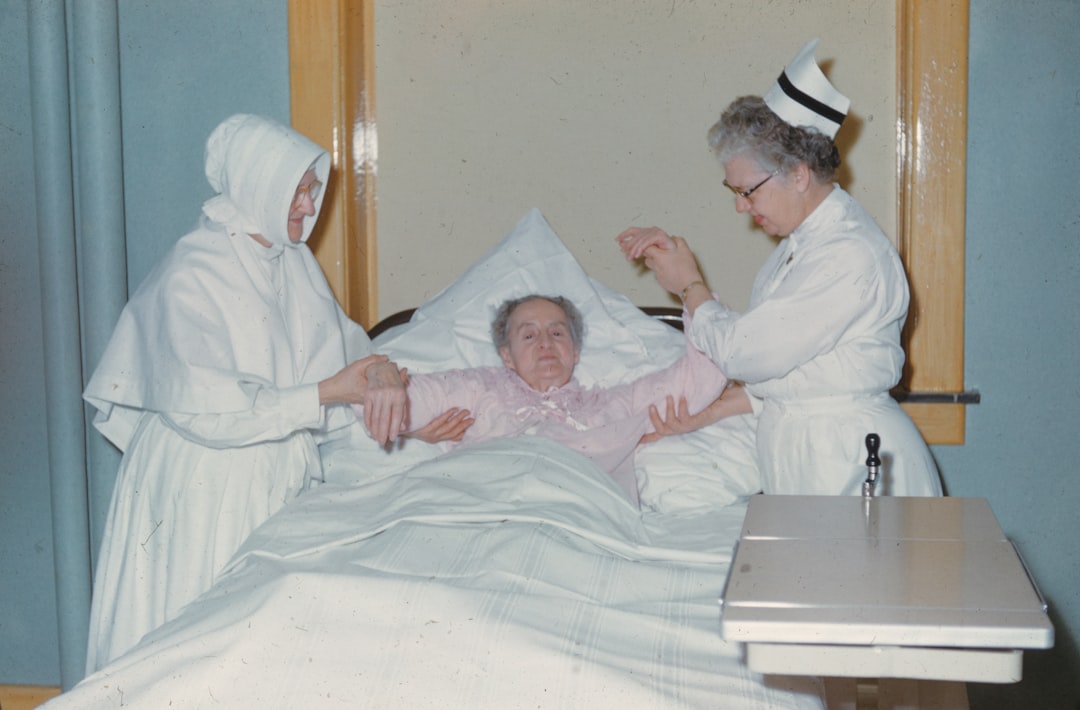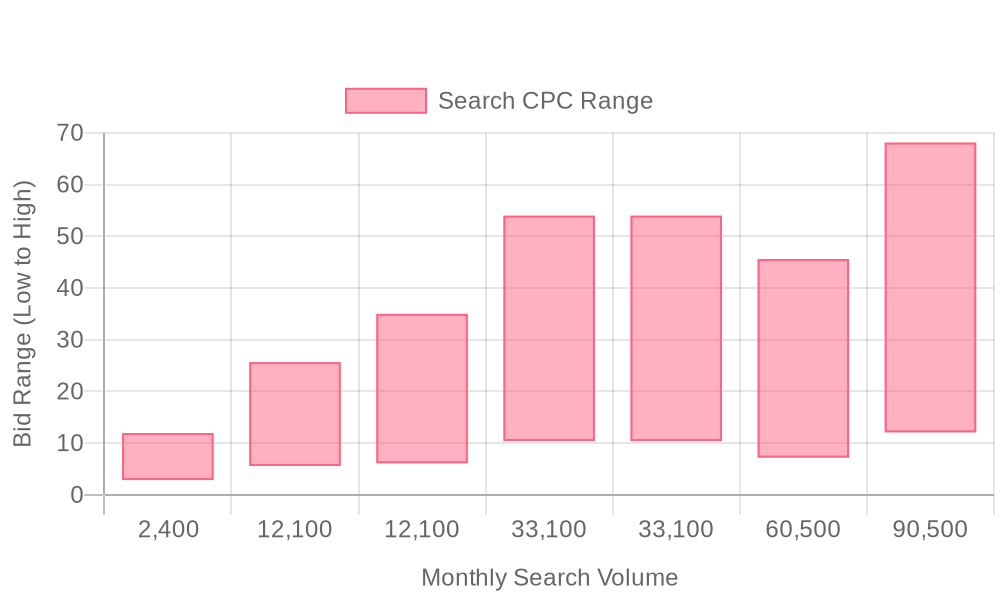
Supercharge your lead generation with a FREE Google Ads audit - no strings attached! See how you can generate more and higher quality leads
Get My Free Google Ads AuditFree consultation

No commitment
Supercharge your lead generation with a FREE LinkedIn Ads audit - no strings attached! See how you can generate more and higher quality leads
Get My Free Google Ads AuditFree consultation

No commitment
Supercharge your lead generation with a FREE Meta Ads audit - no strings attached! See how you can generate more and higher quality leads
Get My Free Google Ads AuditGet My Free LinkedIn Ads AuditGet My Free Meta Ads AuditFree consultation

No commitment
Supercharge your lead generation with a FREE Google Ads audit - no strings attached! See how you can generate more and higher quality leads
Get My Free Google Ads AuditFree consultation

No commitment
Navigating Google Ads for Medical Training can be a labyrinth, especially with the complexity of compliance in healthcare marketing and the need for precision in targeting. Often, high-value prospects are missed because they are not tracked, leading to lost opportunities. As medical training organizations strive to capture a larger share of their audience’s attention, Google Ads offers a unique gateway. For instance, the lack of visibility into anonymous traffic means potential leads often remain unknown and unpursued. Whether it's promoting Certified Medical Training Ads or targeting seasoned professionals through Healthcare Professional Training Workshops, understanding how to leverage these digital marketing tools can be transformative. Integrating Google Ads with Learning Management Systems (LMS) while ensuring Google Ads compliance can address these challenges by helping you track and optimize your digital marketing strategies effectively. This guide will equip you with the knowledge to harness Google Ads as part of your broader healthcare lead generation strategy.

Healthcare education marketers can accelerate enrollment growth by applying advanced digital marketing for healthcare strategies, using granular targeting and real-time audience engagement to capture high-intent prospects. Delivering timely, relevant messaging to healthcare professionals searching for certified medical training ads ensures programs remain top-of-mind during key decision periods.
Integrating predictive analytics and dynamic audience management into Google Ads for Medical Training eliminates the guessing game around lead qualification. When visitor identification technology ties anonymous traffic to named organizations, revenue teams can prioritize outreach to buyers who are actively evaluating medical training courses.
To see how these strategies work in action and streamline your enrollment marketing, get started for free with Sona.

Medical training organizations operate in a fast-evolving landscape where competition for student enrollment and practitioner engagement is increasingly steep. With Google Ads, these programs effectively reach highly specialized audiences—such as trauma care coordinators, surgical technologists, and continuing medical education (CME) seekers—at the critical moment they search for relevant courses or certifications. For an overview of how Google Ads drives results in healthcare marketing, see using Google Ads in healthcare marketing. This direct access eliminates wasted impressions and helps marketing and sales teams respond to genuine intent signals, reducing friction caused by fragmented data or slow lead follow-up.
The ability to promote CME programs in real time is a game changer for driving registrations and maintaining program relevance. When prospects express interest, immediate engagement is crucial to prevent valuable leads from losing interest or turning to competitors. Google Ads empowers medical training providers to stay top-of-mind throughout the decision journey, ensuring timely communication and nurturing of every inquiry.
For organizations facing tight windows for class start dates or regulatory recertification, Google Ads enables the deployment of highly targeted, time-sensitive campaigns. This immediate response capacity surpasses traditional outbound approaches, accelerating the path from inquiry to enrollment. Digital marketing for healthcare leverages precision targeting to boost online visibility, especially in underserved or emerging geographic regions where awareness is limited and efficient reach is essential.
Advanced technology now allows training providers to optimize for predictive buying stages, using live behavioral data to identify when medical professionals are most likely to convert. By shifting budget and bidding strategies toward those showing in-market behavior, teams maximize healthcare lead generation outcomes. Platforms equipped with real-time visitor identification and CRM integration further enhance Google Ads campaigns by revealing which companies and individuals are actively researching medical training, allowing for dynamic audience updates and high-impact, personalized outreach as leads progress through the funnel. To see these capabilities in action, get started for free with Sona.


Targeting growth opportunities in medical training advertising requires a refined approach that goes beyond generic healthcare PPC. Medical training providers who zero in on specialized vertical keywords can reach audiences with immediate intent, ensuring that every click is more likely to turn into a qualified inquiry or enrollment. For actionable insights on niche healthcare PPC, review this overview of Google Ads in healthcare marketing and explore proven tactics in our B2B marketing playbooks.
Ready to uncover new growth opportunities? Get started for free with Sona.

Audience segmentation for medical training programs requires more than broad demographic filters. The most effective digital marketing for healthcare uses a nuanced approach, aligning program offerings with the unique needs of diverse medical professionals and students. Precision segmentation minimizes wasted spend by ensuring only relevant, high-intent leads enter the funnel, improving both engagement and conversion rates for healthcare PPC campaigns.

| Industry | Keyword | Monthly Search Volume | Competition Level | Low Bid | High Bid |
| Medical Training | medical training | 2400 | LOW | 2.87 | 11.95 |
| Medical Training | medical assistant school | 12100 | MEDIUM | 5.59 | 25.66 |
| Medical Training | medical coding classes | 12100 | MEDIUM | 6.11 | 35 |
| Medical Training | billing and coding classes | 33100 | LOW | 10.4 | 53.98 |
| Medical Training | medical billing and coding school | 33100 | LOW | 10.4 | 53.98 |
| Medical Training | medical billing and coding certification | 60500 | LOW | 7.21 | 45.59 |
| Medical Training | medical billing and coding classes | 90500 | LOW | 12.09 | 68.11 |
Precision in keyword strategy is vital for medical training organizations seeking to maximize every dollar of ad spend. By identifying and targeting decision-makers at the moment they are searching for relevant certifications or educational resources, marketing teams can eliminate guesswork and manual lead qualification, accelerating their pipeline. High-intent keywords act as gateways to direct engagement with healthcare professionals and administrators actively seeking to enroll, upskill, or certify staff, which elevates both relevance and conversion rates.
Advanced conversion tracking completes the loop, attributing both online signups and offline enrollments to specific keyword paths. When CRM and ad platforms are connected, high-value leads can be re-synced into audience segments, ensuring follow-up ads remain highly relevant and compliant. This closed-loop approach enables teams to measure true ROI on keywords, adjust for seasonality in medical education demand, and drive personalized engagement that accelerates program enrollment. To streamline your campaign setup and access these capabilities, get started for free with Sona.
Effective Google Ads for Medical Training begins with precise keyword planning tailored to the unique needs of healthcare learners. Start by identifying long-tail keywords that reflect the specific certifications, locations, and formats relevant to your programs, such as “EMT certification classes in Atlanta” or “phlebotomy night course online.” For an in-depth overview of how Google Ads can attract and retain patients in healthcare, explore this overview of Google Ads in healthcare marketing. The addition of negative keywords, such as “free training” or “volunteer” filters, helps exclude low-value clicks and keeps budgets focused on qualified prospects.
Equally important is the ability to map keywords to the buyer’s journey, predicting whether a visitor is in the exploration phase or ready to register. By continuously reviewing search term reports and integrating real-time intent data, marketers can dynamically update these lists to match changes in demand. Tools that identify anonymous website visitors and match them to company accounts add another layer of value—enabling revenue teams to attribute keywords to actual organizations and adjust targeting strategies based on which healthcare employers or student segments are showing in-market signals.
Ad copy for medical training programs must address both the pain points of prospective students and the compliance requirements of healthcare marketing. Messaging should focus on outcomes, such as accelerated certification, job placement rates, or continuing education credits, to differentiate your offering in a crowded market. To further refine your messaging and stay compliant, review these regulations and best practices in medical advertising. Incorporating trust markers—like testimonials from healthcare employers or statistics on exam pass rates—bolsters credibility while building a sense of urgency with limited-time offers or early-enrollment discounts increases the likelihood of prompt action.
Advanced identification of anonymous visitors enhances this step by allowing marketers to segment audiences based on industry, company size, or stage in the decision cycle. This enables the delivery of highly relevant ad variations, such as tailored messaging for career changers versus current healthcare professionals seeking recertification. When creative is aligned with real-time account-level insights, ads resonate more deeply and drive higher engagement across channels.
Landing pages must be tightly aligned with each ad group, delivering a seamless experience from click to conversion. Each page should have a clear, singular call-to-action—such as “Reserve Your Spot” or “Download Course Guide”—that matches the intent of the original keyword and ad copy. Avoid distractions by eliminating extraneous navigation and focusing attention on form fills, click-to-call buttons, or live chat for immediate engagement.
Personalized landing pages can leverage data from previous interactions, displaying relevant course dates, locations, or instructor profiles based on a visitor’s prior behavior. Marketers using unified data platforms can trigger dynamic content blocks for known accounts, ensuring that decision-makers from healthcare organizations see tailored enrollment offers or cohort-specific pricing. To discover more strategies for effective landing page optimization, check out our marketing analytics blog. This level of precision minimizes drop-off and maximizes lead capture efficiency.
Continuous improvement in Google Ads for Medical Training hinges on robust data integration and responsive optimization. By connecting CRM platforms and ad accounts, marketers can synchronize lead and account data in real time, enriching campaign audiences with job titles, industry segments, and verified intent signals. For a step-by-step guide to leveraging Google Ads for healthcare lead generation, explore this Google Ads for healthcare guide for hospitals. This enables automated budget shifts toward high-converting accounts and fuels lookalike audience expansion, dynamically updating targeting as leads progress through the funnel.
Advanced conversion tracking closes the loop between online ad engagement and offline actions, such as phone inquiries, campus visits, or completed applications. With granular attribution, revenue teams gain a clear view of which keywords, audiences, and creative variants drive true ROI, supporting more informed decisions on where to scale spend or refine messaging. The result is a demand generation engine that not only attracts high-quality healthcare learners but also delivers measurable business outcomes for medical training providers. To put this framework into practice, get started for free with Sona.
Google Ads has become a core channel for healthcare marketers seeking to reach patients at the right moment. Compared to traditional media, it offers precise targeting and clear ROI measurement. For healthcare organizations, paid search can be a powerful lever for driving appointments, but it also comes with unique regulatory and privacy considerations. Marketers should review Google Ads for healthcare marketing before launching campaigns to understand the landscape.
Regulatory compliance remains paramount in healthcare advertising. Patient privacy laws like HIPAA directly impact how organizations collect, store, and use data for ad targeting. To navigate these complexities, marketers can consult guidance on HIPAA compliance for Google Ads.
Building high-performing campaigns requires a deep understanding of keyword intent, ad copy, and landing page experience. Step-by-step resources, such as this Google Ads guide for hospitals, help teams design patient acquisition strategies that prioritize trust and clarity.
Healthcare marketers can also benefit from leveraging audience segmentation and intent data. Platforms like Sona’s Audiences tool allow teams to create real-time, signal-based segments that sync directly with ad platforms for hyper-personalized targeting.
Finally, ongoing education is essential for staying competitive and compliant. Google’s own Skillshop for Google Ads offers official training and certifications to help marketers master the platform’s tools and regulations.
Navigating the world of Google Ads for medical training can be complex, but with the right strategies and tools, it's possible to effectively reach and engage your target audience. We've explored critical aspects such as compliance, crafting compelling ad content, and leveraging data analytics to optimize your campaigns.
Throughout this guide, the main challenges have been addressed, offering insights into best practices for ad creation, targeting, and compliance within the medical training sector. By implementing these strategies, you can enhance your visibility while adhering to industry regulations, ultimately driving more value from your advertising efforts.
As you embark on this journey, remember that the right approach to digital advertising can transform your outreach and educational impact. Embrace these strategies, and you'll likely see a significant improvement in how you connect with aspiring medical professionals and institutions seeking your expertise.
To truly revolutionize your Google Ads strategy, start for free to experience our platform's capabilities today. Discover how unifying your go-to-market data can provide actionable insights and drive success in your campaigns.
Best practices include establishing clear goals and KPIs, conducting thorough keyword research, developing specific ad group structures, designing consistent landing pages, and investing in performance tracking.
To create compliant ads, ensure your ad group structures adhere to industry regulations, use precise targeting, and incorporate trust markers like testimonials while ensuring all campaigns comply with patient privacy laws such as HIPAA.
Key strategies involve integrating Google Ads with Learning Management Systems, using predictive analytics, conducting competitor gap analysis, and employing industry-specific placements to target high-intent audiences.
Optimize by using advanced conversion tracking, integrating CRM data with ad platforms, implementing data-driven optimizations, and continuously refining keyword strategies based on search patterns and intent signals.
Common pitfalls include missing high-value prospects due to lack of tracking, not aligning ad copy with landing pages, and failing to segment audiences accurately, which can lead to wasted ad spend and missed opportunities.
Join results-focused teams combining Sona Platform automation with advanced Google Ads strategies to scale lead generation

Connect your existing CRM

Free Account Enrichment

No setup fees
No commitment required

Free consultation

Get a custom Google Ads roadmap for your business
Join results-focused teams combining Sona Platform automation with advanced Meta Ads strategies to scale lead generation

Connect your existing CRM

Free Account Enrichment

No setup fees
No commitment required

Free consultation

Get a custom Google Ads roadmap for your business
Join results-focused teams combining Sona Platform automation with advanced LinkedIn Ads strategies to scale lead generation

Connect your existing CRM

Free Account Enrichment

No setup fees
No commitment required

Free consultation

Get a custom Google Ads roadmap for your business
Join results-focused teams using Sona Platform automation to activate unified sales and marketing data, maximize ROI on marketing investments, and drive measurable growth

Connect your existing CRM

Free Account Enrichment

No setup fees
No commitment required

Free consultation

Get a custom Google Ads roadmap for your business
Over 500+ auto detailing businesses trust our platform to grow their revenue
Join results-focused teams using Sona Platform automation to activate unified sales and marketing data, maximize ROI on marketing investments, and drive measurable growth

Connect your existing CRM

Free Account Enrichment

No setup fees
No commitment required

Free consultation

Get a custom Google Ads roadmap for your business
Over 500+ auto detailing businesses trust our platform to grow their revenue
Join results-focused teams using Sona Platform automation to activate unified sales and marketing data, maximize ROI on marketing investments, and drive measurable growth

Connect your existing CRM

Free Account Enrichment

No setup fees
No commitment required

Free consultation

Get a custom Google Ads roadmap for your business
Over 500+ auto detailing businesses trust our platform to grow their revenue
Our team of experts can implement your Google Ads campaigns, then show you how Sona helps you manage exceptional campaign performance and sales.
Schedule your FREE 15-minute strategy sessionOur team of experts can implement your Meta Ads campaigns, then show you how Sona helps you manage exceptional campaign performance and sales.
Schedule your FREE 15-minute strategy sessionOur team of experts can implement your LinkedIn Ads campaigns, then show you how Sona helps you manage exceptional campaign performance and sales.
Schedule your FREE 15-minute strategy sessionOur team of experts can help improve your demand generation strategy, and can show you how advanced attribution and data activation can help you realize more opportunities and improve sales performance.
Schedule your FREE 30-minute strategy sessionOur team of experts can help improve your demand generation strategy, and can show you how advanced attribution and data activation can help you realize more opportunities and improve sales performance.
Schedule your FREE 30-minute strategy sessionOur team of experts can help improve your demand generation strategy, and can show you how advanced attribution and data activation can help you realize more opportunities and improve sales performance.
Schedule your FREE 30-minute strategy sessionOur team of experts can help improve your demand generation strategy, and can show you how advanced attribution and data activation can help you realize more opportunities and improve sales performance.
Schedule your FREE 30-minute strategy session





Launch campaigns that generate qualified leads in 30 days or less.
